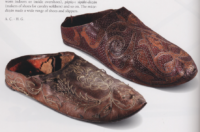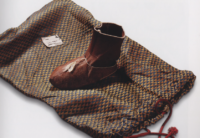Literally “Kurdish,” the kürdiyye overcoat was popular among both sexes in the later part of the century. It was so popular, in fact, that it’s bizarre that we have no good description of it. Standards set by the marketplace governors make it clear that by 1624, it came down to…
Continue reading
Literally the term for a type of thick felt, kebe was also a name for an overcoat made of felt. As the cheapest and least sturdy form of wool cloth, felt was generally a working-class fabric, though some forms of felt–like Yanbolu kebe, a famously hairy and high-quality felt made…
Continue reading
The ağrız is a mystery garment worn by very poor male agricultural laborers (all but one of the recorded wearers are escaped slaves) and made of the mystery fabric “ağrız,” which was probably a variety of felt. As igriz (or rarely agriz), it appears in Ottoman-era 16th-century Hungarian customs records. It’s…
Continue reading
The nezkeb–or nezkep, mezkep, or mezkeb, among dozens of other pronunciations–is something of a mystery. It’s a decorative and often highly valuable scarf worn as part of a woman’s headdress. Records from the imperial workshops suggest nezkebs were woven to half the width of standard cloth; marketplace price lists record…
Continue reading

The edik was a low shoe, much like a modern babouche, that was the standard street footwear for people who didn’t need serious foot protection. It was worn over a soft leather sock called a mest or iç edik.
Continue reading

For most people, the first layer of footwear was a soft leather sock called a mest or an iç edik (inner shoe). It was worn indoors. To go outside, people slipped the mest into an edik, or outer shoe. Leather socks were one of the Arab innovations that traveled alongside…
Continue reading
The çember or çenber, literally “circle,” is a band of folded fabric wrapped around a woman’s pillbox-shaped hat. It can be decorative, or when a woman wears a hat veil (makrama), it’s tied over top of the makrama to hold the makrama on.
Continue reading
The makrama (or makrame) is a short veil, usually white, that goes over the top of a woman’s hat and ties under her chin to hold the hat on. It’s commonly depicted hanging loose and untied, the better to show off the decorative embroidery along the edges.
Continue reading
The gömlek was a cotton, linen, silk (if you were female), or occasionally woolen shift worn by both men and women next to the skin. Women’s gömleks were usually shin-length to ankle-length, depending on the fashion. Men also wore long gömleks with their full-length kaftan, or a hip-length version of the gömlek with…
Continue reading

In mid-16th-century sources, “arakçın” is simply a word for any hat. By the end of the century it appears to have attached to women’s hats in particular, but it describes the pillbox hats of the 16th century, the small cones of the turn of the century, and the sugarloaf hats…
Continue reading






